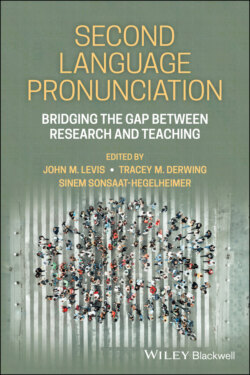Читать книгу Second Language Pronunciation - Группа авторов - Страница 35
L2 pronunciation
ОглавлениеProponents of the Critical Period Hypothesis (CPH) argued that L2 speech learning is fundamentally different from L1 speech development. In their view, the mechanisms used in L1 speech learning are no longer available, and instead, L2 learners must rely on general learning mechanisms, which are not optimized for speech (Scovel, 2000). While the CPH was once an appealing explanation for why adult L2 learners rarely achieve nativelike pronunciation, no clear empirical evidence has been found to support it. In contrast, strong evidence now favors a more nuanced understanding of L2 pronunciation development. Flege et al. (1995a, 1995b) investigated the L2 English pronunciation of Italian immigrants to Canada who had arrived at a range of ages from early childhood to adulthood. They found no critical biological period after which the ability to acquire a nativelike accent precipitously declined. Instead, the relationship between age of arrival and strength of foreign accent was found to be linear. Therefore, while these studies provide evidence that it is better to learn L2 pronunciation at a younger age, they appear to falsify the CPH’s claim, that the learning mechanisms used in L1 acquisition are lost during brain lateralization. Flege et al. (1997) later established that the strength of individuals’ L2 accent is also strongly correlated with the quantity of their L2 experience and the extent to which L2 learners continue to use their L1s in everyday life. Taken together, this evidence suggests that the perceptual mechanisms utilized in L1 learning remain intact over the lifespan, but that accessing them becomes increasingly difficult. L2 learners are no longer a blank slate but come to the task with established L1 categories and typically fewer opportunities to obtain impactful experience with the L2 (Flege, 1995; Flege & Bohn, 2021).
It appears, then, that the automatic nature of L1 speech perception after the age of four is what most conspires against adults easily accessing speech learning mechanisms. Unfortunately, after these perceptual processes have become automatic, it is difficult to notice the phonetic-level information needed to categorize sounds in a new language. Instead, L2 sounds are automatically filtered through L1 perceptual categories. Best and Tyler’s (2007) Perceptual Assimilation Model (PAM) and Flege’s (1995, see also Flege & Bohn, 2021 for an update) Speech Learning Model (SLM) are the most often-cited explanations of L1 influences on L2 learning. Both argue that the relative dissimilarity of L1 and L2 speech sounds predicts how easy it will be for L2 learners to acquire sound categories in a new language. When L1 and L2 speech sounds are identical, or nearly so, a simple substitution will suffice. Nothing needs to change regarding the automatic processing for such sounds. When an L2 sound is unlike any sound category in the learner’s L1, new category development is also likely to occur, but it may take some time. The greatest challenge in L2 pronunciation learning presents when one or more dissimilar L2 categories are perceptually assimilated to a single L1 category. For example, a Japanese L2 English learner may perceive both English /l/ and /ɹ/ to be equivalent to a single Japanese apico-alveolar tap /ɾ/. This misperception of two contrasting English categories causes Japanese speakers to substitute their /ɾ/ sound for both English /l/ and /ɹ/. It happens to be the case that despite the Japanese category not being a perfect example of English /l/, English L1 listeners perceive it to be closest to their /l/ category, and perceive it as such. This results in English L1 listeners recognizing Japanese attempts to pronounce English /l/-/ɹ/ word pairs as homophonous (e.g., their renditions of “right” and “light” are both perceived as foreign-accented versions of “light”). Similar assimilation patterns occur for learners of other L2s. For example, English learners of a Hindi alveolar and retroflex stop contrast typically assimilate both Hindi categories to English /t/ (Guion & Pederson, 2007).
In the case of the English /l/-/ɹ/ contrast, acoustic information needed to discriminate these sounds is tuned out by Japanese L1 speakers, since it has no importance in their language (Brown, 1998). Similarly, English L1 learners of Mandarin tonal contrasts cannot easily recognize tonal distinctions because pitch cues associated with Mandarin tones are not used in the same way in English (Guion & Pederson, 2007). In sum, the primary source of difficulty in L2 pronunciation development is learners’ inability to reorient attention to phonetic information that they have learned to ignore (Chang, 2018). The processing efficiency that was an advantage to L1 learning has now become an impediment in L2 learning. To successfully learn L2 sounds, learners must re-educate this selective perception (Strange & Shafer, 2008). In the next section we will see that this is indeed possible.
